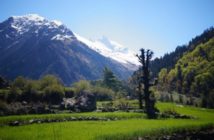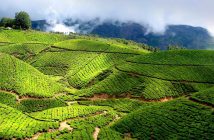Hampi, the city of ruins is a UNESCO World Heritage Site, owing to the ancient temples, forts and other monuments here.
Hampi was the capital of the Vijayanagar empire around 1500 AD, and by some accounts, the second largest city in the world at that time. Over the next centuries it fell out of importance, and now you can explore the ruins of a lot of temples and other structures spread out over a vast area. The terrain around Hampi is as mysterious as the ruins itself – the city is surrounded by boulders of different sizes, and you can climb to the top of them with a little effort to get a stunning view of the entire city and the geography. It is located on the banks of the Tungabhadra River. Famous for its massive, beautifully carved temples, especially the Virupaksha Temple, dedicated to the patron deity of the empire. You can also find remains of the old aqueducts, canals and military barracks and stables here. Hampi was declared a UNESCO World Heritage site in 1986 and many efforts have been taken to restore the lost glory of the place – very limited (if any) modern establishments are allowed in the main area, which gives an authentic feel to the ruins.

For Whom
People interested in history and ancient architecture, backpackers. Ideal for school/college excursions.
The enchanting ruins
Covering an area of 30 square kms, Hampi has a large number of monuments which are preserved in excellent condition. The Virupaksha and Vitthala temples are the most famous and do-not-miss monuments, but take a walk (or cycle) through the city for hours, and you’ll be happy to see a lot of less popular temples/palaces and other buildings which are equally as fascinating. Most of the ruins are located in the northern part of the city, just south of Tungabhadra river, and the rest of them are scattered all across the city.
The hippie island
While most tourists stay to the south of Tungabhadra where most of the ruins are located, some prefer the north banks which has a vibrant hippie culture. There are a lot of chilled out cafes here serving awesome food along with chilled beer, and most of these have a great view of either the river or the beautiful rice fields. A lot of these cafes also serve as guest houses and you can get simple rooms here at cheap rates.
Restaurants and Local Food in Hampi
Given the number of foreign tourists that visit Hampi, it has a flattering variety of cuisines from all over the world. All of the restaurants are contentrated in the small markets on both sides of the Tungabhadra river – although the northern side definitely has a lot more variety and better cafes. You will find a lot of restaurants serving Italian (pasta/lasagna/pizzas) and Israeli (lafa/shakshouka) food, along with the usual Indian food.
Most of the cafes here are very laid back, so expect leisurely service and a chill ambience with pleasant music and some scenic views. If you would like to get a good view, crossing the river to the north side is definitely worth the effort – there are some cafes with a view of either the river or the rice fields.
admin
Latest posts by admin (see all)
- 30 Inspirational travel quotes to fuel your wanderlust - August 12, 2018
- Can I find myself - August 12, 2018
- Trip to Rashol, The Picturesque Valley Near Parvati River - August 12, 2018



